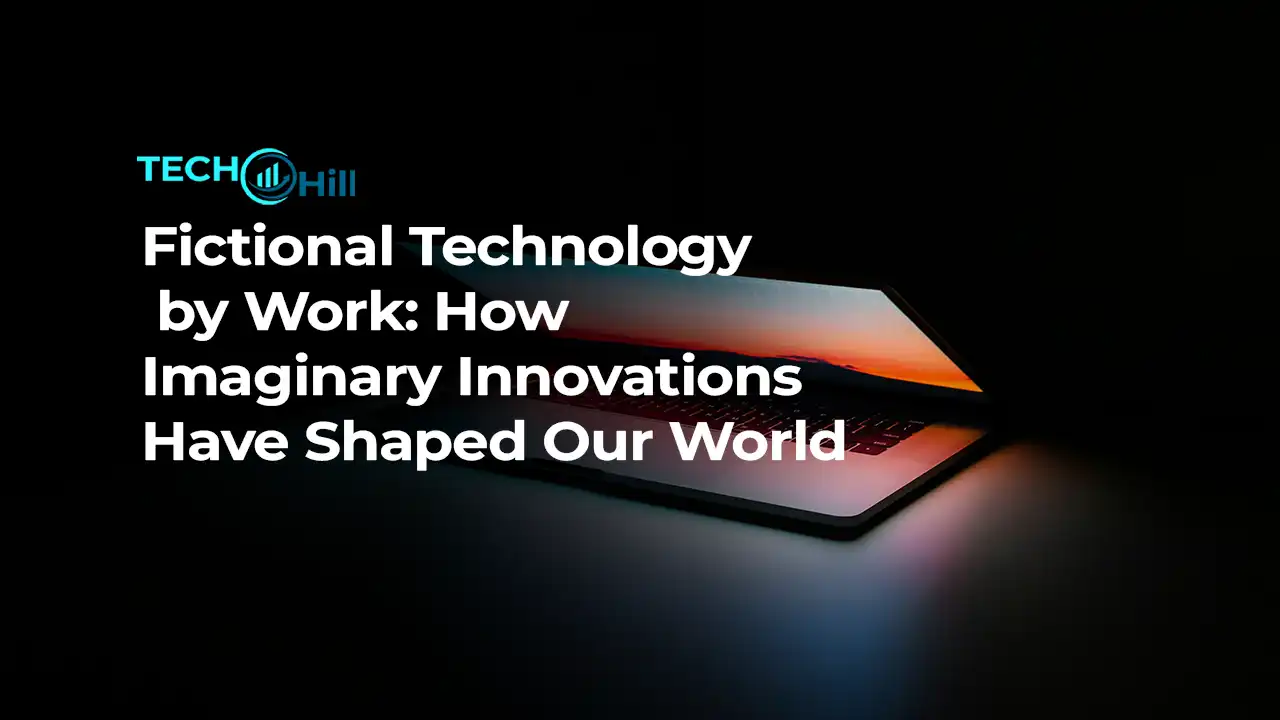Fictional Technology by Work: How Imaginary Innovations Have Shaped Our World

Fictional technology isn’t just a product of the imagination; it’s a driving force that inspires real-world innovation. From literature to movies, TV shows, and even video games, fictional technology has sparked ideas that have transformed into actual advancements. Whether it’s the communicators in Star Trek paving the way for modern smartphones or the virtual worlds in The Matrix influencing virtual reality (VR), creative works have often been a precursor to technological breakthroughs.
This article delves into how fictional technology has evolved across various mediums, including literature, movies, TV shows, and video games, and explores its broader impact on real-world developments. We’ll also examine the ethical, social, and political commentary these fictional technologies often present and discuss what the future may hold for creative works in terms of technological innovation.
The Origins of Fictional Technology in Literature
The roots of fictional technology can be traced back to classic literature, where authors have long explored the possibilities of future inventions. Mary Shelley’s Frankenstein is often cited as one of the first instances of science fiction, with its portrayal of a scientist creating life through unorthodox means. Fast forward to the works of Jules Verne and H.G. Wells, and you see imaginative technologies like submarines, time machines, and space travel.
Verne’s 20,000 Leagues Under the Sea introduced the concept of a fully operational submarine long before such a vehicle was feasible. Similarly, Wells’ The War of the Worlds depicted futuristic war machines that mirrored real military advancements years later. These early literary works planted seeds for the development of technological innovations we see today.
The Role of Speculative Fiction
Speculative fiction, a broader genre encompassing science fiction, fantasy, and dystopian themes, has always been a playground for exploring potential technologies. Whether it’s George Orwell’s 1984 and its depiction of surveillance technology or Aldous Huxley’s Brave New World with its genetic engineering concepts, speculative fiction often provides a warning or a vision of what our world could become. The relationship between these fictional depictions and real-world ethics becomes particularly significant when considering the social impact of technology.
Fictional Technology in Science Fiction and Its Influence on Real Innovations
Science fiction has had a profound influence on actual technological developments. The works of Isaac Asimov, Arthur C. Clarke, and Philip K. Dick, among others, have shaped the direction of scientific inquiry and innovation.

From Page to Reality: Fictional Innovations That Became Real
One of the most fascinating examples is how Arthur C. Clarke’s 2001: A Space Odyssey predicted tablets and AI long before they became everyday technologies. Similarly, the concept of the “robot” popularized by Karel Čapek’s play R.U.R. gave rise to the real-world robotics industry.
Another notable example is Star Trek, which introduced the concept of teleportation, communicators, and advanced medical devices like tricorders. While teleportation remains purely fictional, communicators served as the inspiration for early mobile phones, and today’s smart devices offer functionalities that were once confined to sci-fi.
Fictional Technology as a Design Blueprint
Designers and engineers often take cues from fictional technologies when building real products. The influence of science fiction on fields like aerospace, biotechnology, and even wearable tech can’t be overstated. Elon Musk’s SpaceX endeavors, for instance, are heavily inspired by sci-fi narratives that envision humanity as an interplanetary species. Even VR systems and simulations are drawing from older concepts like the holodecks of Star Trek and the immersive worlds of The Matrix.
Fictional Technology in Movies and TV Shows: A Visual Revolution
Movies and TV shows have a unique advantage in visualizing fictional technologies. From sleek gadgets to fully realized virtual environments, these visual mediums bring to life ideas that written text alone might struggle to convey.
How Star Wars and Star Trek Shaped Popular Perceptions
Two of the most influential franchises, Star Wars and Star Trek, have deeply embedded the idea of fictional technology in popular culture. Star Wars introduced the idea of lightsabers, droids, and hyperdrives, while Star Trek showed us holodecks, replicators, and the warp drive. The visual representation of these technologies has become iconic, influencing everything from pop culture to actual scientific discussions on the feasibility of such inventions.
The Rise of Cyberpunk and Its Impact on Technology Perception
The cyberpunk genre, exemplified by works like Blade Runner and Ghost in the Shell, explores a world where high-tech meets low-life. The depiction of mega-corporations, cybernetic enhancements, and AI-driven societies presents both the allure and dangers of advanced technology. These visual narratives don’t just entertain—they also provoke thought about the ethical implications of such technologies.
When considering celebrity workouts and the role of social influencers, we can draw a parallel to how cyberpunk often critiques the commodification of every aspect of life, including our bodies and health.
The Impact of Fictional Technology in Video Games
Video games are another frontier where fictional technology thrives. Unlike movies or books, games offer an interactive experience, allowing players to engage directly with imagined technologies.
Virtual Worlds and Immersive Technologies
Games like Deus Ex, Mass Effect, and Cyberpunk 2077 present not just narratives but also environments where fictional technologies like augmented reality (AR), brain-machine interfaces, and advanced AI are central to the gameplay. The experience of interacting with these technologies in a game format can influence how people perceive them in reality.
The Influence of Gaming on Real-World Tech
Games have inspired real-world tech developments, particularly in areas like AR, VR, and AI. The rise of virtual worlds in games has paved the way for social spaces like the metaverse, where people interact in a blend of real and digital worlds. Concepts like “hacking” in games have also shaped how cybersecurity is approached in real life.
Technological Themes in Fantasy vs. Science Fiction
While science fiction is often centered on what is technologically possible, fantasy leans more into magical systems and otherworldly powers. The distinctions between these genres also influence the types of fictional technology they introduce.
Fantasy’s Approach to Technology: Magic as an Equivalent
In fantasy, “technology” often manifests as magical objects or systems. For instance, the Lord of the Rings trilogy features the One Ring, a powerful artifact that functions as a kind of “ultimate weapon.” In contrast, science fiction tends to lean more on plausible technologies, even when they are far-fetched, like time travel or space exploration.
The Hybrid: Science Fantasy
Genres like science fantasy blur these lines, combining technological themes with elements of magic. Works like Star Wars, with its combination of lightsabers and the Force, show how the merging of these two realms can create rich storytelling possibilities. Such hybrids also challenge conventional notions of what is possible, opening up new avenues for innovation and creativity.
Social, Ethical, and Political Commentary Through Fictional Technology
Fictional technology doesn’t just entertain—it often provides a lens through which we can examine the ethical, social, and political implications of real-world technological advancements.
Dystopian Technology: A Cautionary Tale
Dystopian fiction, from 1984 to Black Mirror, explores the dark side of technological progress. The idea of surveillance, loss of privacy, and the potential for totalitarian control are common themes. These cautionary tales prompt discussions about the ethical responsibilities that come with technological advancements.
Ethical Dilemmas and AI
One recurring theme in fictional technology is the ethical dilemma surrounding AI and robotics. Asimov’s Three Laws of Robotics laid a foundation for thinking about machine ethics. Today, as AI becomes more integrated into society, questions about autonomy, rights, and responsibility are more relevant than ever.
Technology and Social Inequality
Fictional technology also serves as a commentary on social inequalities. Cyberpunk worlds, for instance, often depict societies where access to technology is divided along class lines. The wealthy benefit from enhancements, while the underprivileged are left to deal with the consequences. Such narratives highlight the potential dangers of technological monopolies and the widening gap between different social strata.
The Future of Fictional Technology in Creative Works
As we move further into the 21st century, the relationship between fictional technology and real-world innovation will likely grow even more intertwined.
Emerging Technologies and Their Fictional Counterparts
New developments in quantum computing, biotechnology, and space exploration are providing fresh material for creative minds. Fictional depictions of these technologies can both inspire and critique their real-world counterparts, serving as a feedback loop that shapes both innovation and societal values.
The Role of AI in Creative Works
AI itself is now being used to generate creative works, blurring the line between human and machine authorship. How will this impact the development of fictional technology? As AI tools become more sophisticated, they might not just create, but also influence the very narratives around technology in creative works.
Conclusion
Fictional technology, whether found in the pages of a novel, on the silver screen, or in a video game, plays a crucial role in shaping our understanding of innovation and its consequences. As technology continues to advance, the boundary between what is real and what is imagined becomes increasingly blurred. The creative visions of today might very well be the realities of tomorrow, making fictional technology an ever-relevant subject in both art and science.
